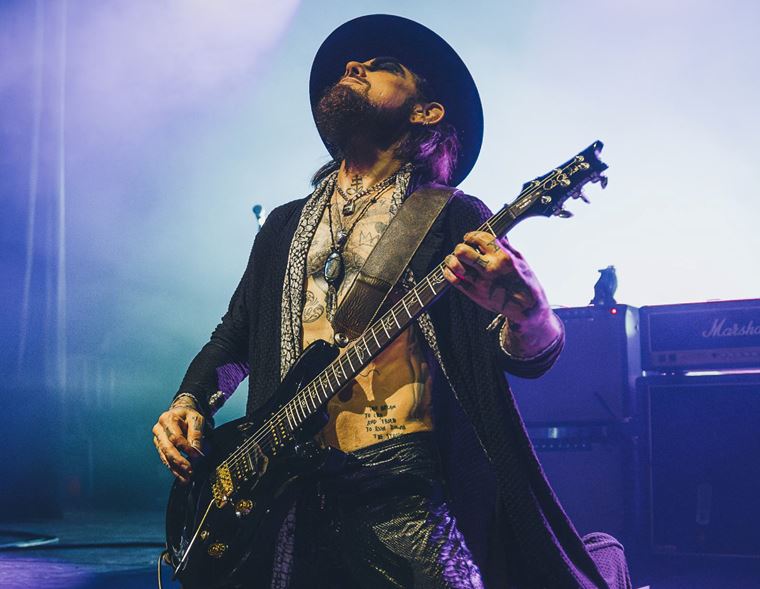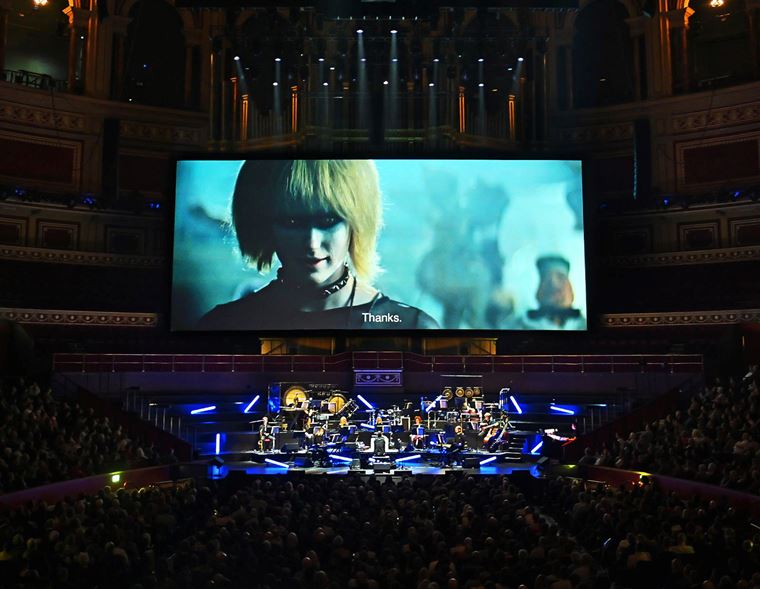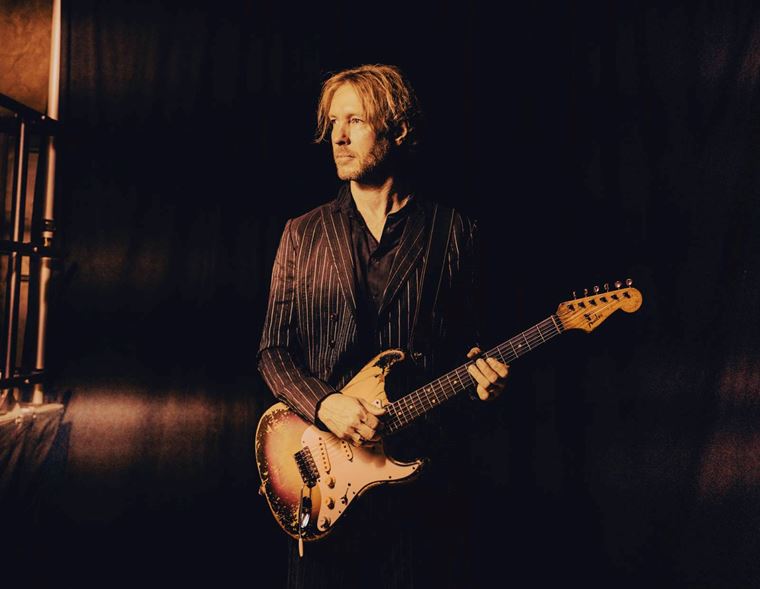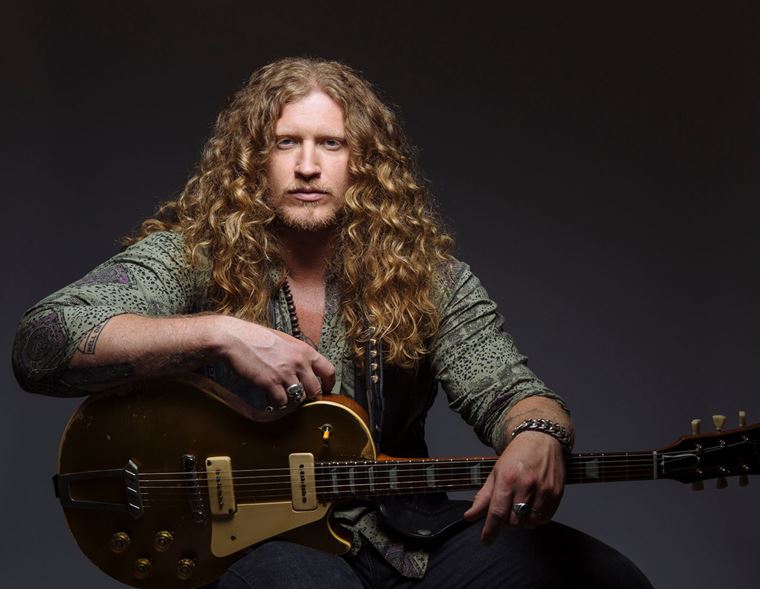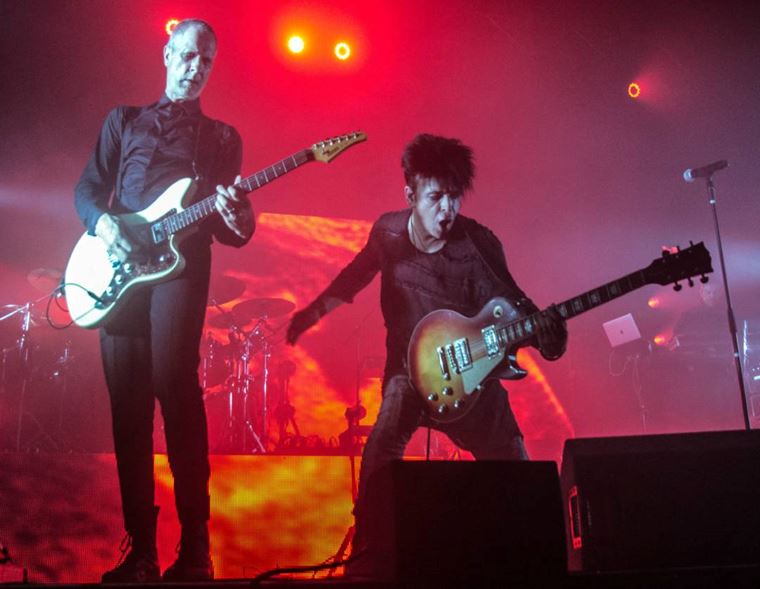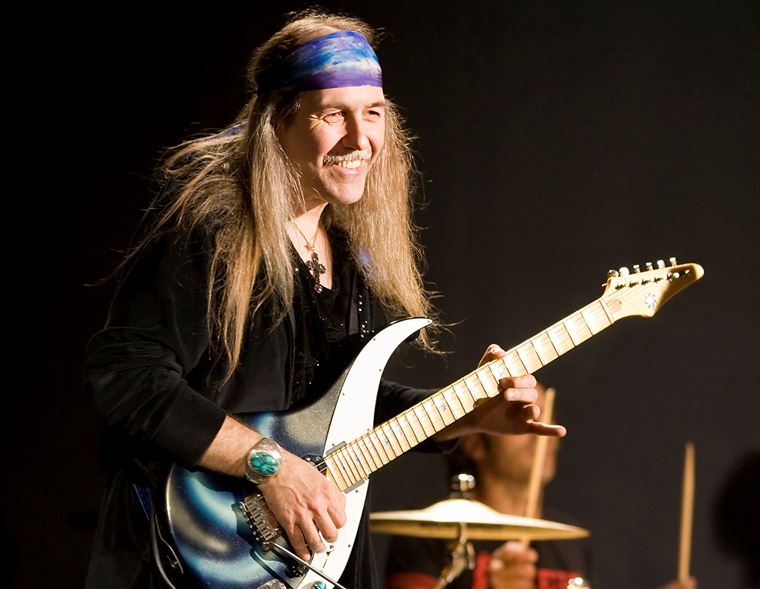guitarguitar Talks to TOMAHAWK'S Duane Denison
Published on 02 April 2021
As far as ‘alternative guitar hero’ status goes, Duane Denison is one of the greatest. A truly iconoclastic player, Denison has provided an angular, expressive and powerful new vocabulary for left-of-centre players for decades now.
Denison initially found fame as a founding member of the Jesus Lizard, whose off-kilter and somewhat sinister riff rock brought a darker, subversive angle to the 90s US rock scene. Hailed as innovative and influential on masses of huge bands like Nirvana (with whom they released a split-single), Steve Albini and Mastodon, the Jesus Lizard remain an intense and potent proposition when listened to today.
However, Duane’s career didn’t stop there by a long shot. His other most famous band is Tomahawk, the experimental and cinematic band he formed with Mike Patton twenty years ago. Tomahawk have an uncompromising, colourful and hard-hitting sound that takes in the vibes of dark Americana, spaghetti Westerns and David Lynch-style dark ambiance, blended with a healthy dose of the sharp, pulverising riffs that Denison is noted for.
Tomahawk very recently released the superb Tonic Immobility, their 5th album and first since 2013. It’s powerful, atmospheric stuff, with Denison of great form as he weaves around Patton’s masterful, multi-layered vocals. Joining these two on this release are Mr Bungle’s Trevor Dunn on bass and Helmet’s John Stanier on drums. We don’t like the term ‘supergroup’ but it’s kind of apt in this situation. These guys are legends!
Recently, we had the opportunity to remotely chat to Duane via a Zoom call from his home in Nashville. What is an alternative guitar legend like in conversation? Well, we found Duane to be excellent company: funny, razor sharp, encouraging and humble, as well as being very ‘able’ to talk about his technique and process. In other words, the perfect person to chat guitars with! As you’ll read, we touch on quite a few subjects in our chat, including the genius of Robert Fripp, the importance of how notes finish (not just how they begin) and why it’s important to like high-end gear, but to not be a gear snob!
It is our great pleasure to bring you this full, in-depth interview with Duane Denison.
Duane Denison Interview
Guitarguitar: Thank you for joining me today Duane!
Duane Denison: Oh, thank you!
GG: I figure if we just chat about riffs and guitars, we’ll be good!
DD: Sure.
GG: Cool! So, the new record, Tonic Immobility: am I right in saying that was actually recorded in a few different locations?
DD: No, that uh, that’s wrong. (laughs) The instruments were pretty much all recorded here in Nashville. We started that probably 3 years ago, or so. Mike’s schedule is weird and all that. We had already done demos, so we knew what was going on, which way it was going. So we did that here, and Mike did his vocal stuff in his studio in San Francisco.
GG: Ah, okay. In terms of the demoing process, I may well be wrong, but my impression of Tomahawk is that it starts with you. Do you come up with the initial musical ideas?
DD: Yeah! Yes, absolutely. From the start, it was a collaboration between myself and Mike. I would come up with some basic musical ideas. He would add vocals, samples, whatever, and then we’d kinda get everybody together and do the final arrangement. And this was no different, but it’s funny: we’ve been doing this for 20 years on and off. In the beginning, I would send him cassettes of acoustic guitar with a metronome, and then it went to CDs from a workstation, through the mail, and now its files. You send someone digital files and they stream them or download them, and you work from there. It’s kinda funny: we’ve watched the technology change, but we don’t change that much.

(Photo: Joshua Black Wilkins)
GG: Mm, yeah. So, do you tend to write on an acoustic guitar rather than the electrics?
DD: Oh, it’s about half and half. To me, the basic idea should be able to stand on its own really, no matter what you’re playing it on, whether it’s a keyboard or a guitar or a bass, acoustic or electric. My basic ideas don’t tend to be...what would I say...very sound specific. I’m not dependent on this exact kind of sound to make it happen, you know what I mean?
GG: Yes, totally! With that kind of context of you beginning the songs, I’m thinking of the fact that you are writing material knowing that Mike Patton’s going to be putting his vocals over the top. Does that move your guitar playing in a certain direction that maybe it wouldn’t have in the Jesus Lizard days? Does that influence you?
DD: Yes. Not in a huge way, but in a ‘somewhat of a way’. David Yow and Mike Patton are both great vocalists, and they both have their unique attributes.
GG: Uh-huh.
"We all are big fans of soundtracks and soundtrack composers. I think it’s natural over time. If you’ve played in rock bands your whole life, you start to look for other things to listen to, and the soundtrack world is a pretty good world."
DD: With Patton, he can kinda navigate chord changes that maybe are a bit more... shall we say elaborate, or a bit more far-flung, and he can come up with vocals and things in a way that really nobody else does, I think.
GG: For sure.
DD: And so for that reason, it’s kind of liberating, I guess I’d say.
GG: Okay, yeah. I’m thinking of the ideas themselves forming to begin with. Are you somebody who likes to stockpile riffs, like, you’d stock playing when something catches your ear and then you record it on your phone or whatever?
DD: Yeah, absolutely! Sometimes, you know, you come up with something when you’re noodling around and you really like it. You play it over and over again so you memorise it. And so, you know – at least I know – that I’m not gonna forget that. There’s other times where it just pops up outta nowhere and you say, ‘Well, I’d better record that before it goes away’. Sometimes I’ll go through the whole thing of hooking up an interface and everything and go direct into a computer – in my case, it would be Cakewalk software – uh, but sometimes, honestly Ray, I still have an old cassette recorder! I still have some new cassettes that I’ve saved, (laughs) and I still have this Radio-shack cheap recorder with a built-in speaker. Sometimes you wanna get it right then and there! I don’t wanna mess with the phone, I don’t wanna mess with the digital world, I just wanna hit ‘record’ and there it is, you know what I mean? And you can listen back to it, right there. I like the simplicity of that.
GG: Yeah, that’s fantastic! Now, I’m sure you get this a lot, but there’s something very ‘visual’ about Tomahawk’s sound. I wondered, when you approach playing the guitar, do you think in terms of pictures and visual information, and then try to represent that?
DD: Yeah, I mean sometimes you start off with that, you start off with a graphic image, but more often than not for me, I’ll start off with a sound. Maybe you’ll set some parameters, let you’ll say to yourself ‘I want to write something’. Sometimes you’ll improvise and it just happens. A lot of does it doesn’t, and you have to make it happen. And I find that if you deliberately limit yourself from the whole endless amount of things to choose from, if you limit yourself and say ‘Okay, I’m going to come up with something fast or slow, high or low, thick or sparse, choppy and irregular or smooth and steady. So, start narrowing the parameters and then a lot of times the visual thing will come out of what you’ve come up with. You come up with something and then it starts to take off.
There’s a song on the album called Fatback. That riff is in 13/8. I deliberately said to myself ‘What’s the most evil thing I could do right now? Oh, well I could use the number 13, so let’s start with a 13/8 time signature!’ I mean, I literally said that. But it was fun, it started as a joke and then became like a real song. The more I listened to it, I was like, ‘Man, this song just cruises along, it’s like a nuclear submarine just cruising along dark waters. I like that, let’s keep that’. And so that kinda visual thing comes along and yeah, it can inspire you.
We’ve always tried to think of ourselves – perhaps pretentiously so – as cinematic rock, or a la francaise: rock cinematique! We all are big fans of soundtracks and soundtrack composers. I think it’s natural over time. If you’ve played in rock bands your whole life, you start to look for other things to listen to, and the soundtrack world is a pretty good world because on one hand you’ve got serious composers who are writing interesting things that aren’t necessarily rock, and yet it still is accessible; it still is with the audience in mind and being evocative. So yeah, we’ve always kinda gone for that.
GG: Yeah! Wow, you have touched on so many points that I wanted to get to there! (laughs)
DD: I hope so! That’s what I’m trying to do! I’m getting the questions out of the way for you! (laughs)
GG: Totally! You’re so right about the film soundtrack thing. Even something as simple as John Williams’ Jaws theme: that could easily be a guitar riff, really, couldn’t it?
DD: Yeah, yeah, absolutely.
"When I’m doing a solo, I try to always have a really good or interesting entrance, and a really good exit."
GG: And so, Fatback, the song you mentioned, is one of the new album’s high points for me. What I wanted to ask about that specific one – and I can’t wait to talk about your guitar sound – but the solo in Fatback is pretty unusual. I wondered if you’d share how you came up with the sound and also, in your approach to playing solos in general, do you tend to write them out in advance or improvise in the moment?
DD: Half and half! (laughs) Half and half. And not like I’m copping out there, but to me, the most important thing in a solo in a rock context...so, you want it to be memorable, right? You want it to connect with people and be memorable, otherwise you might as well just be playing jazz or something, where it’s just another solo and it’s like polite applause (laughs). For me, when I’m doing a solo, I try to always have a really good or interesting entrance, and a really good exit. Make a splashy entrance and make a memorable exit, like an actor, and everything else in between just kinda falls into place.
In this case, on that one, the busy ending: I’d definitely planned that. But the rest of it, it starts off mostly on different version of one note. I’m hovering over one note whilst the rest of the music is sort of smashing around behind me. Then it gets a little faster and fluid and then ends on that long, cascading run. So yeah, that was definitely half and half: I knew how I wanted to end it, but I didn’t know how I wanted to get there, so I played around, and I really thought that sometimes just kinda mad-dogging the one note is the way to start! It worked this time.
GG: Oh yeah, totally! And how about the sonics behind that particular sound? It’ s a very unusual tone.
DD: Um, that was an all-aluminium guitar. That was an Electrical Guitar Company guitar, aluminium neck and body with P90s, really high output, low noise, so it was fairly sharp. I don’t remember exactly what the effects or the amp were on that particular thing. But in general, on that album, I use either the Line 6 Helix, the big full-on one, and I still have a TC Electronic G-Force, which I pull out now and then. So, between those two, most of the sounds came out from that.
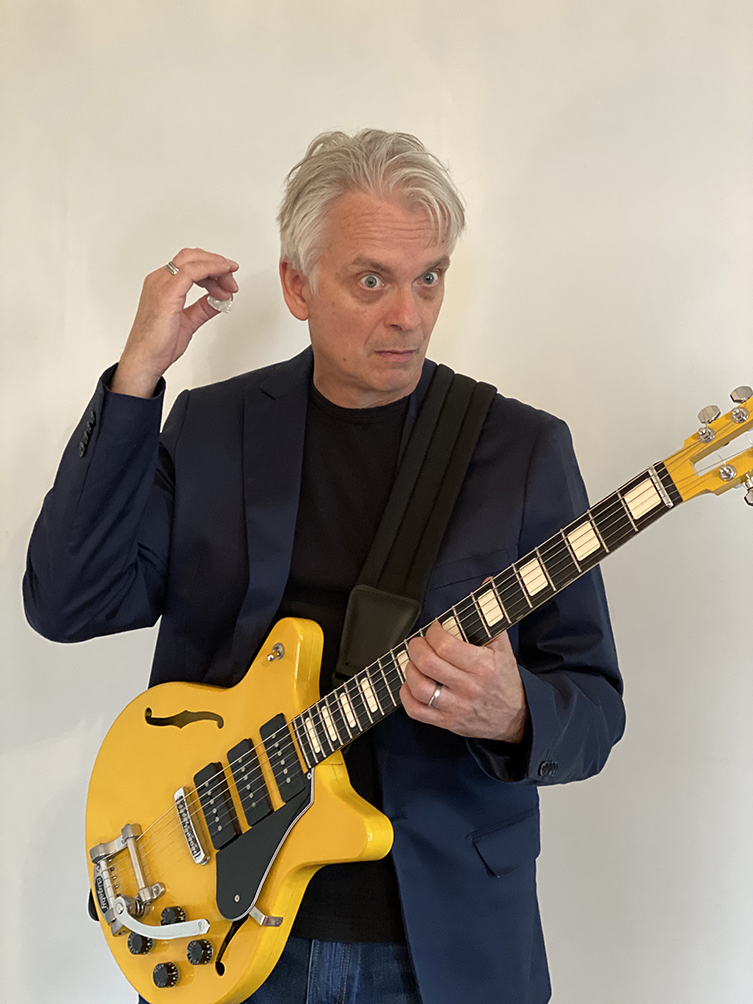
(Photo: Elizabeth Gregory)
GG: Okay, that’s interesting. Now, one thing I’m thinking, and this may have developed from your earlier days with Jesus Lizard and so on, but we’ll take the new album as an example. There’s what I would term ‘close up’ sounds and then what I’ll call ‘further away’ sounds. I really like the way you seem to paint with them, for example the close-up sounds are sharper and more direct, and they seem to be your crunchier rhythm parts, but there’s more of this impressionistic playing before it at intervals. Is that how it goes? You can go wilder with the effects when things are in the atmosphere, but when you have them close you need to keep them more (punches fist)?
DD: Yeah! Absolutely. I think that, when you’re making an album, typically the band is playing, and the guitar is playing what I’d call rhythm guitar parts. To me, you want – at least most of the tie – to keep those as tight and dry and focused as possible. You can always add something later if you want, but I think when you’re recording, keeping those as focused and clean as possible helps you play more rhythmically. You can be tighter and more focused on the track. And then absolutely, when you start doubling guitar parts or adding solos and atmospheric tracks, you definitely want to take advantage of room sound. First off, going for a bigger, roomier sound, and then adding effects from there.
GG: For a single guitar band, you’re responsible for all of that sound area, if you like, What I love is that you seem to have a really great sense of when A; not to play, because you don’t just go all the way through a song without even stopping, and B; when you decide that something is more important and needs to be the main event like that sound that plays throughout the song Eureka. How did you create that sound, by the way? Is it a slide?
DD: I’m just playing a guitar with an E-Bow and a slide.
GG: Right.
DD: And maybe a ducked delay so it kind of fades in and fades out.
GG: Does that suggest itself to you? Is that one of those times where you think up a certain kind of sound in your mind, and then it’s a matter of ‘finding’ it?
DD: Well, that piece in particular was basically a sound collage. There’s no drums on it, I don’t think there’s any percussion or anything, it’s kind of what you might consider a palette cleanser. It’s about two thirds of the way through the album, you’ve had ‘rock’ every which way, so let’s just kinda clear the air for a minute before the last three songs show up! (laughs) So, that one is more deliberately atmospheric and weird, I guess I would say.
GG: Uh-huh. But those types of elements still show up within the context of the ‘bigger’ songs.
DD: Throughout all the songs, we were definitely more conscious – or at least I was – of using more space, letting things clear out. Most of the songs, at least half the time not everyone is playing at the same time. Things drop out, so there’s space where you can hear more of the vocal, or if the vocals drop, you can hear more of the guitar or keyboard part. I’ve also kind of gone for that. It’s funny, Patton tends to be kind of the opposite: if you listen to a lot of his parts, they tend to be full and thick and busy. I have to push to get my way on things! (laughs) But it works, and the other guys had to admit that it worked and the space sounds good.
GG: Cool.
DD: I won.
GG: Hahaha!
DD: We all win! (laughs)
GG: That’s it, everybody wins! I wonder, with that kind of context of sculpting the sound rather that adding more and more layers, would you say that it makes the heavier stuff sound more dramatic since there’s more relative impact there?
DD: Absolutely. Something sounds bigger and more massive when its coming from a point of nothingness. You can’t just keep hammering people constantly, or we just turn off to it. At least, I do.
GG: Yeah.
DD: I just kind of shut off, and I want some space. I’ve said this before, but I truly mean it: you more space you provide, the listeners imagination will fill in the blanks anyway. You kind of hear and think of things, or mentally start picturing things that aren’t there. I think that’s a cool thing, I like that, so to me, the more space you have, the more that is allowed to happen.
GG: That allows the visualising that we spoke about earlier to occur at the other side of it, with the person listening rather than the person creating.
DD: Yes.
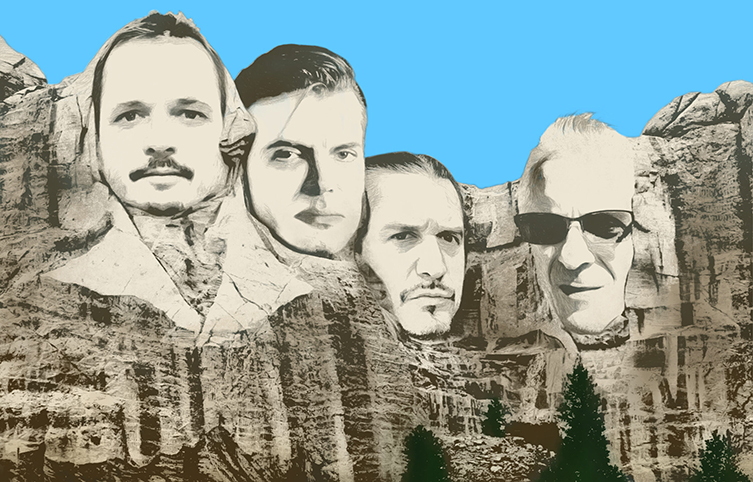
(Photo: Eric Livingston)
GG: Cool, now your main guitar sound – I don’t want to reduce it to one thing, but it’s fair to say you’re famous for having a certain crunchy tone...
DD: Yeah.
GG: Would I be right in saying that you’re actually using less gain than I might be expecting? It’s a really powerful sound, but it’s also quite clean. You mentioned about tightness earlier: you can’t really be that tight if you’re absolutely saturated, can you?
DD: Yeah, um, to me it’s a very fine line but in general, I like to have a certain amount of twang and a certain amount of crunch to it. I do play a bit crunchier now than I did in the 90s maybe, just over time I think I like having a slightly heavier, thicker sound. But in general, no, compared to other supposedly heavy guitarists, my tone is not nearly as saturated and there’s a good reason for that. I want to hear...I don’t just want the chords to turn to mush. That kind of heavy overdriven sound is fine if you’re playing strictly power chords, I think it’s great for that! But when you’re playing anything else, it kind of becomes mushy and indistinct. I wanna hear the notes. I wanna hear the string! In fact, I’d go as far as to say I wanna hear the space between the strings (laughs), if we wanna get conceptual here. You can’t do that with something is overly saturated and thick. I also think that, with saturation comes a certain amount of compression, and when something becomes overly compressed, the dynamics go away.
GG: Yeah.
DD: It tends to even out the attack, which in some cases is good, sometimes that’s okay but other times no, you want the touch to be able to come through a bit more. It’s hard to do that when you’ve got a lot of saturation and compression, so I try to avoid that.
GG: Mm, yeah. And the idea of allowing the dynamic to remain, within your own instrument, is kind of important to Tomahawk. Seems to me, anyway, that the dynamic range is as important as the atmosphere, as kind of signifiers of each other. That’s kind of what your sound is!
DD: That is part of the song. That is part of the part! You can have the best riffs and the most killer beat and all that, but if you don’t provide the right kind of space and the right dynamics, it’s just flat. Everything moves along at the same level and once again, your mind just kind of shifts off because nothing is jumping out at you.
GG: Definitely.
DD: You can overdo it: extreme dynamics can eventually become as dull as no dynamics, so you have to watch it.
GG: It’s a fine line, but Rock n Roll is all about explosions, and you do want to give the listener a bit of that.
DD: Yeah!
GG: So, going back to your guitar sound. On this record, something like the opening track ‘SHHH!’, when it comes in heavy: taking that as an example, would you be getting all of your drive from your amplifier, or are you using overdrive pedals? Or indeed, the Helix?
DD: I use a lot of different stuff, and I don’t keep notes on things. I know some people do when they’re in the studio: they’ll make a note of what amp, what signal chain etc, and I don’t. Now that song in particular, the opening riff is very clean, that pizzicato thing is very clean.

(Photo: Elizabeth Gregory)
GG: Certainly.
DD: Then it goes to these big sort of slabs of barre chords coming in.
GG: Yeah, that part.
DD: All I can say on that, I tended to, on the cleaner stuff, it would typically be Fender or Hiwatt. Then for the more full stuff, Marshall, Blackstar, things like that. JCM800 Marshall of Blackstar HT, and I find those sound really good and work really well. And you can mix and match, like Fender came out with the Supersonic series a few years ago and when you crank those up, they sound really good! And Hiwatt obviously, you can crank those up and get drive. In fact, I’ve got a Hiwatt Little J and a cabinet. That, and putting a drive in front of it, like a Tubescreamer or something, sounds monstrous. It sounds really good.
GG: Nice! Nice. Now you mentioned your Electrical Guitar Company instruments, and of course you’ve got your signature model.
DD: Yes.
"I wanna hear the notes. I wanna hear the string! In fact, I’d go as far as to say I wanna hear the space between the strings, if we wanna get conceptual here."
GG: If I was describing your sound to people, there are two words that keep coming back to me. One of them is ‘energy’ and the other is ‘sharp’. When I say sharp, I don’t mean tone, it’s more about your timing and your style. You think that’s about right?
DD: Yes, and once again the tone helps delineate that. To me, playing in time, if you’ve got once again too much saturation, too much overdrive, if you want those rhythm guitar parts to be tight, you’ve got to not just have the attack on the beat, you’ve gotta cut those notes off on the beat. I’ve noticed with certain types of amps at certain settings, you can mute those chords and there’s still this ‘whoomph’, there’s still this overhang.
GG: Yeah.
DD: Now, some people find this desirable. In certain genres, that’s part of the sound, and I get it. But for what I do, no! I want ‘you cut those notes off on the beat just as sharply as the attack’. That’s how, to me, I define the sound in the way I play, in the riffs. You can’t make that work with too much of an overdrive.
GG: That’s interesting, that the end of the note is as important for your style as the beginning. I don’t think a lot of people talk about that!
DD: Attack and release! You have to cut that note off to be just as sharp as the attack.
GG: And with that notion of this explosive sharpness, is that part of the reason why you chose the aluminium guitars in the first place? Do they help with that?
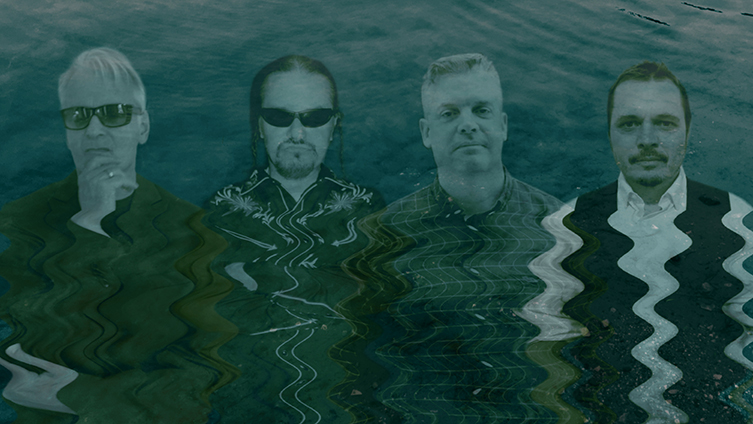
(Photo: Eric Livingston)
DD: Um, they do but I go back and forth between aluminium and wood all the time. I thought about it the other day and I’ve been doing it since Pere Ubu. In the late 70s, Kramer made aluminium neck guitars and I had one. They were heavy and clunky and, like, ‘Ok, go away’. Then in the 90s I discovered Travis Beans, the Travis Beans and the Hiwatt, and yeah, that definitely lends itself to that style of playing where you’ve got these really high output, low noise pickups set in a metallic frame, it brings out a sharpness to the attack and a sharpness to the release: you can cut it off sharply as well. Then I got away from those and went and played other things: a Gibson ES-135, which I used on some of this album. I also used a Schecter, a Solo II Special, their version of a Les Paul Special. For a reasonably priced Asian import, those are great.
GG: Oh, yeah!
DD: They sound great, they play great, there’s nothing wrong with them. I am not a snob. I like high-end gear, but I don’t turn my nose up at something just because it’s popular or reasonably priced. You know, Blackstar amps sound great etc etc. Anyway, I kinda go back and forth between them and every now and then I’ll hear old tapes or videos of myself playing back in the day on completely different gear. I saw one the other day and I was playing a Yamaha guitar through a Lab Series amp and I sounded basically the same as I do now! It sounded almost exactly the same. (laughs) I really think that once you’ve got your style and technique together, you can kind of make that happen on almost anything.
"The David Bowie Scary Monsters album: the guitar playing on that is just, for modern rock n roll guitar, dissonant, noisy, aggressive. That just defined it for me."
GG: Yes, I expect that’s quite true. One area that I wondered about in terms of the minutiae is the realm of string gauge, tunings and picks. I don’t even know if you’re in standard tuning or not! Are you in standard?
DD: Uh, yeah, most of the time. On this album, there were three different tunings: standard, Drop D and then there’s a third one I use that I call drop G. Drop the A down to G, and drop the B string, to B flat. So, you’ve got this nice Gm chord or a minor chord in the middle four strings. Forget the two outside ones. So, if you’re playing slide, like on Business Casual, you’ve got this nice minor chord that oy can slide around, or a minor 7th chord, depending on how you’re fingering it, that you wouldn’t be able to get otherwise. Also, on Business Casual and Predators and Scavengers, I use that same tuning, and you can do double stops and harmonics. Natural harmonics are now thrown off as well, right? Because of that one string change, so you can kind of make things happen like that harmonic melody at the beginning of Business Casual. I don’t think that would’ve happened without that tuning.
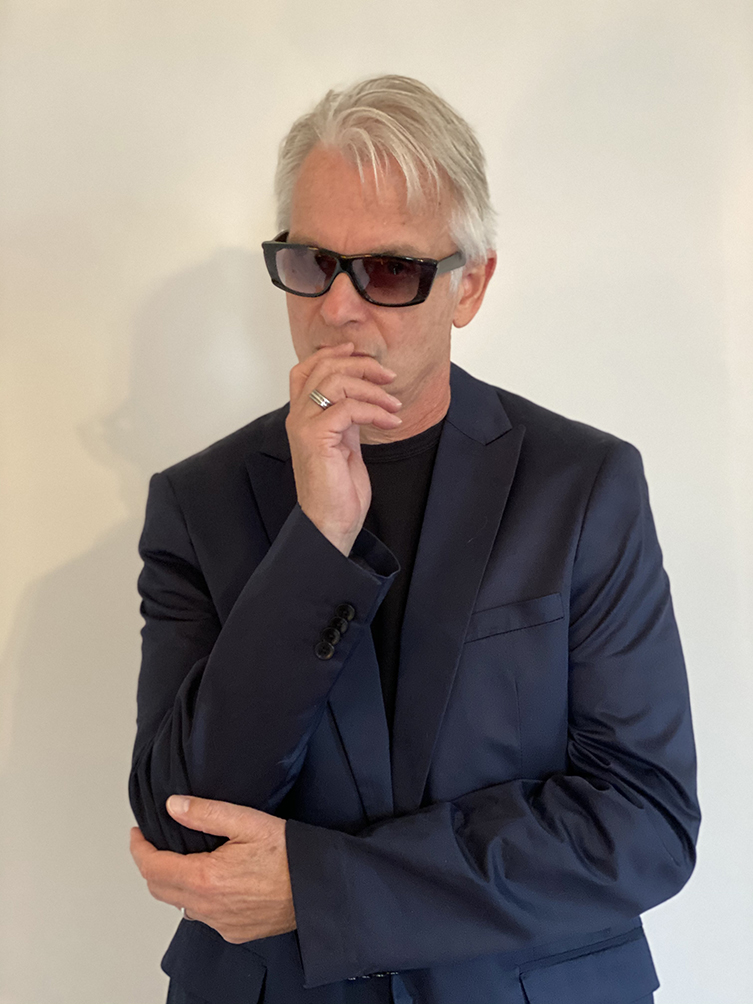
(Photo: Elizabeth Gregory)
GG: That’s amazing! I love the idea of the shiftable minor chord. Before I go back to the strings and the picks, does that mean you have a specific guitar set up for slide playing?
DD: No, whatever is within reach! And for strings, I almost always use Dunlop, depending on the scale length of the guitar. If it’s a 25 or up, I find I can use heavier strings, 11 to 48 or 50 and then for a Gibson or Gretsch scale, 24 and three quarters, I find 10-42 or 44 seems to feel right. It’s not a hard and fast rule but I find that typically works. You can use heavier strings on a longer gauge, and they feel right.
GG: Okay, and what about plectrums? Do you have a preference for one in particular?
DD: Oh, just mediums, just bog standard, any kind of medium: Fender medium, Gibson medium. Not too heavy, not too light. Nothing special; no copper, no Mexican pesos (laughs).
"From an early age, I just thought, ‘Well, I don’t wanna sound like them. I don’t wanna be just like all these other guys, I wanna do my own thing."
GG: Haha, fair enough! Whatever works! Now, we’ve nearly covered everything but there’s a couple of questions I’d love to have your thoughts on. I think your guitar paying is really interesting and I love listening to it, and one of the reasons I like hearing it so much is because I’m so sick of hearing the same old pentatonic, Blues-based riffs over and over.
DD: Yes!
GG: That’s something I don’t get from you. Did you consciously swerve that world?
DD: Yeah! Absolutely! Absolutely, and it’s not like...I don’t hate the Blues, I have respect for those guys and all that, but there are so many people doing it, that from an early age, I thought, ‘I don’t want to just be another one of these guys’. I grew up in the Detroit area. I was born in Ann Arbour and grew up in the suburbs of Detroit, where ham-fisted, meat and potatoes rock and roll ruled! There were a lot of, you know, professional guitar players all over the place. And from an early age, I just thought, ‘Well, I don’t wanna sound like them. I don’t wanna be just like all these other guys, I wanna do my own thing’, and so I just made a decision. I practised different things, studied different things, listened to different things and filtered it through, at the same time, kind of a more punk rock or post-punk mentality.
When I was a teenager, it was prog rock and glam. So, on the one hand you had Steve Howe, Robert Fripp, Yann Ackerman, John McLaughlin, and then on the other side you had Slade, T-Rex and stuff like that. And then post-punk came along, and that’s when it got interesting. I liked the punk rock energy, but to me, Johnny Ramone and Steve Jones were kinda regressive, and I don’t mean to diss them, but it only goes so far. But then the next wave, when you had, say, Andy Gill from Gang of Four, Geordie Walker from Killing Joke, Keith Levine from Public Image Ltd, John McGeoch from Magazine & Siouxsie and the Banshees. That’s when it got good.
And then, since you asked (laughs), then I took that in and I was pretty young, still and I thought, ‘I still don’t see a way in for myself’. But then in America, the underground scenes started coming up with Black Flag and Husker Du and Sonic Youth, Butthole Surfers, Big Black, Naked Raygun and Scratch Acid. And I said, ‘Okay, now I see where I belong’. Mixing the post-punk, minimalist thing with the more, shall we say, esoteric, porgy vibe, and that’s where I’m coming from.
The blues-rock thing is fine, but it’s been done to death by so many people, that there’s no reason for me to do it, right?
GG: Oh yeah, 100%! Just out of interest, were you a fan of the Discipline-era King Crimson with Adrian Belew and Tony Levin? That was at a kind of post punk time.
DD: Not as much as earlier. Not as much as the previous one, Red. The album Red still astonishes me. The stuff that Fripp did when he moved to New York City, suddenly now he’s playing with David Bowie and Talking Heads. I thought that stuff was amazing because – it’s funny, I’ve thought about this a lot – because he wasn’t concerned about being ‘impressive’ in the same way that he was with King Crimson. He was just kinda running, getting off the hook, doing stuff that was sometimes chaotic and sometimes beautiful. The David Bowie Scary Monsters album: the guitar playing on that is just, for modern rock n roll guitar, dissonant, noisy, aggressive. Sometimes it’s more atmospheric and other times it’s very busy and just coming at you. That just defined it for me.
GG: Yeah, like Fashion. Can you believe that was a hit single and it had all of that atonal playing over it? It’s beautiful!
DD: Yeah!
GG: It’s really brave. So yeah, that’s really interesting. So, given that you were looking away from the blues for your sound, in Tomahawk, I kind of hear these other things coming in... obviously, the Anonymous record was linked to Native American folk music, but on this album, do I hear some kind of Caribbean or Latin influences?
DD: Absolutely.
GG: Ah, so is that coming from yourself as well?
DD: Me and Mike, because we both really like Dub and Ska and those kinds of things. We’re both familiar with it and we liked it whether it was Jimmy Cliff or Buju Banton. For me, some of the guitar payers, like Ernest Ranglin is one of my favourites. So, yeah, we touch upon that but hopefully not in an obvious ‘punk rock band, now we’re gonna do our ska song!’ For me, it’s more about the feel and the atmosphere than trying to mimic the style of it.
‘It’s a shoot-out at the OK Corral, John Wayne’s wearing a dress...you know, Klaus Nomi shows up. Who’s gonna win?’
GG: Yeah, it’s not musical tourism, you just happen to be into it. I was just getting a flavour coming through it.
DD: Absolutely, yeah. And even when you’re doing a song that isn’t necessarily in that style, when you have that approach – like the dub approach, where the guitar pop in and have a certain shattering reverb-ey sound – then it gives it a nice flavour, a little extra colour.
GG: It’s colour that I think is missing from a lot of rock music, from artists who tend to have just one overall sound, and that’s one of the things I like so much about listening to Tomahawk. Yes, it’s in the context of heavy rock, but it’s quite a colourful listen, and a lot of that’s the guitar, of course.
DD: Yeah, well thanks! And you know, we touch on samples and there’s a touch of keyboards here and there. And a lot of vocal dubs, which frames the guitar nicely.
GG: If you’re writing a song, and you send it over to Mike, is that where your input on what he then does, ends? Do you have to kind of go with whatever Mike decides to do?
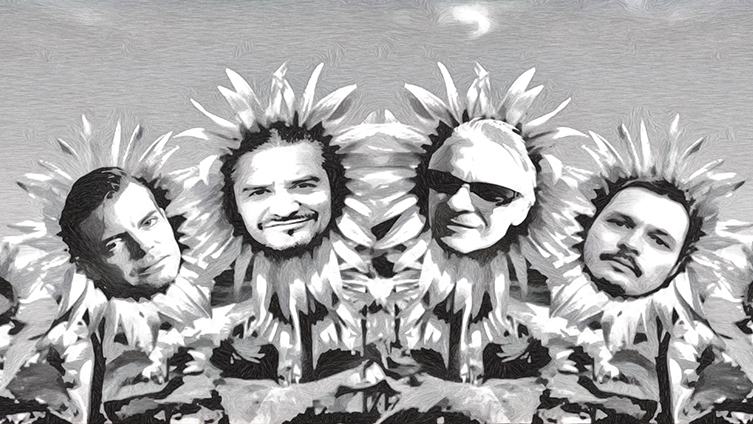
(Photo: Eric Livingston)
DD: No, not necessarily. Usually, I would send things in batches. I would make a batch of three or four things, try to find things that fit together, yet contrast a little bit. That’s how I like to hear things too. And then sometimes, he’ll hear something and he’ll say, ‘Man, I know exactly what I think is gonna sound good there. I know exactly what I’m gonna do’, and he’s usually right. He’s pretty good at it, he’s been doing this a while! (laughs)
But sometimes he doesn’t know. He’s like, Man, I am baffled. I don’t know where to start on this. Can you give me any direction?’ And I’ll throw something out. It might be a musical thing, like, ‘When you start off, why don’t you harmonise with the guitar thing and see where that takes you. Why don’t you sing a measure behind? Why don’t you sing in between the lines: don’t sing along with something, sing between it.’ Other times, it might be just a nonsense verbal thing, like I mentioned earlier to someone: ‘It’s a shoot-out at the OK Corral, John Wayne’s wearing a dress...you know, Klaus Nomi shows up. Who’s gonna win?’ (laughs) I hope Klaus Nomi would win, but yeah, sometimes little things like that are all it takes to push things along.
GG: That’s good man, that’s like a surreal version of those Oblique Strategies cards that Brian Eno gives out to bands when he’s getting bored in the studio. Like, ‘You are the disgruntled ex-guitarist of an African rock band; play you notes you were not allowed to play before’, that kind of thing!
DD: Yeah, right? ‘You live in a collective and you’re running out of food’, ‘world tension is at an all-time high’! Yeah, I think we don’t have to be quite as...whatever, controlled and pretentious as the Eno way of doing things, but yeah, I get what you’re saying.
GG: A little bit of that works, but not too much.
DD: Yeah.
GG: Now, I think we’ve covered everything I had hoped to, which is great! I do have one final question, and it’s one of those slightly basic last question situations, but I’d love to hear your answer to it!
DD: Yeah, sure.
GG: Here it is: what, in your opinion, is the job of a guitarist in a rock band?
DD: (slight pause) Um, without over thinking it, your job is rhythm and atmosphere. Rhythm, you should lock in with the drums, because to me, rock n roll is all about having those rhythms jacked up at a much higher level than they are in other styles of music. Right from the start, right form the old days of Elvis and Chuck Berry. That guitar, the rhythm guitars, are driving it right along with the drums.
And atmosphere. Sound effects, whether reverb or whatever. You’re providing atmosphere for the vocals, really. I mean, this is rock music: without being too carried away with the instrumental side of things, you still wanna connect with people and usually it’s the vocals and whatever that song is about that’s a big part of that, obviously. So, to me: rhythm and atmosphere is what that guitar should do.
Wise words from an epic player. As you’ve read, we covered a lot of ground, and it was a real pleasure to not just have a great conversation, but to hear such fresh perspectives on many aspects of guitar music. I got the feeling that we could’ve gone on a lot longer, which is something I often say after such an occasion! Needless to say, a lot of his viewpoints are things we can all take onboard and experiment with, taking his adventurous attitude as an example.
Tomahawk’s newest album, Tonic Immobility, is available now on Ipecac Recordings. We’d like to thank Duane for his time and for such an insightful, interesting conversation. Thanks also go out to Lauren Barley for putting us in touch.
Most of all, thank you for clicking through and reading this article! Be sure to head over to our guitarguitar interviews page to find much more like this!
Until next time
Ray McClelland

